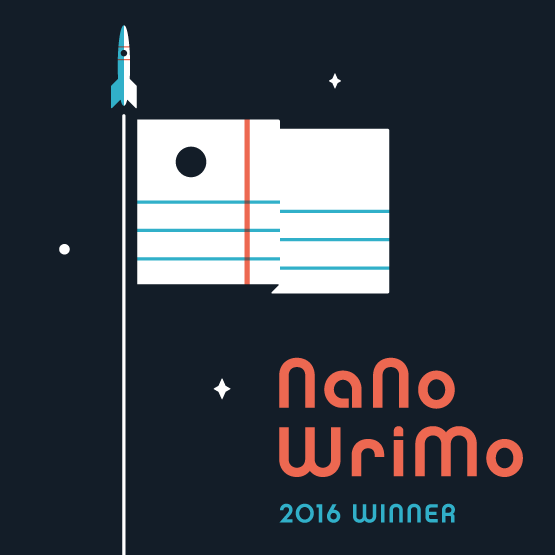NaNoWriMo 2016
Another year, another NaNo: this was my thirteenth National Novel Writing Month, and my thirteenth victory. (I took a two-year vacation a couple of years ago.)

The NaNoWriMo forums continue to suffer from strict regulation of threads. The entire month of Scrivener discussion was once again crammed into one infinitely long and not particularly informative thread. I used Scrivener again this year, in combination with my new project template for it, Scree.
I wrote earlier about my decision to write a hyperfiction story for NaNoWriMo this year using Scree, Scrivener, and Twine. It started out easier than a linear novel, but about halfway in the overhead in complexity began to cut into my word count gains: I was constantly trying to untangle and reunite, or just remember, the threads of my plots. The expected zombies never showed up, making my working title at the NaNoWriMo site even more inapt than usual. On the bright side, I got to pick a Kenny out of my cast of characters and kill him in lots of different and fun ways—and in general, sudden and tragic endings are an entertaining way to tie up those ever-multiplying loose threads.
For cat-vacuuming distraction, I made a few Twine story formats, over and above the ones for import into Scree. At some point Twine progressed from version 1 to version 2, and in the process left the popular “scrolling” story format Jonah behind. I didn’t port Jonah to Twine 2, but I made an adequate replacement for my purposes, called Paloma. Paloma is based on the Twine 2 story format Snowman, which uses a combination of plain JavaScript and Underscore templating for scripting. Paloma tracks history on a per-passage basis, foregoing the checkpoint method found in the real Snowman. And, of course, it scrolls passages.
I also made a “proofing format” for displaying a Twine story as a dot graph, called, simply, DotGraph, which produces graphs in the style of this Chimney Rock map. (For more graph styles, check out this history of the art.) Of course a Twine story doesn’t have page numbers, so the default numbers are actually passage IDs. You can also change the settings or just hover to see the passage title instead. I started out coloring for length, but later added coloration for tags in order to use them to make some visual sense of the structure of my story.
I’ve also been reading the Twine forum during my 50,000 words, where I heard about few betas of the next sub-version of Twine 2; I tried them out, built from scratch, and reported a few bugs. I also read a few linked stories there.
On the literary side of hyperfiction, I found a few interesting blogs about the subject, especially those by Emily Short and Sam Kabo Ashwell, and a magazine, Sub-Q. I also watched the flood of Twine stories on the free Twine hosting service philome.la via their twitter feed, and read a few. I discovered the incomparable Girth Loinhammer that way, but in general I recommend finding a more moderated forum to satisfy your hyperfictional needs.
Philome.la did impress me with the sheer numbers of Twine 1 users still out there (you can guess pretty well from the visual appearance of a story which Twine version was used, or view the source), and I decided to make a Twine 1 version of DotGraph. I should probably backport Paloma as well, but I haven’t yet. I also have several more ideas for tweaking DotGraph.




